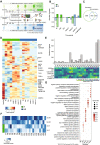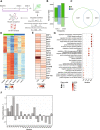Longitudinal multi-omics analysis identifies early blood-based predictors of anti-TNF therapy response in inflammatory bowel disease
- PMID: 36153599
- PMCID: PMC9509553
- DOI: 10.1186/s13073-022-01112-z
Longitudinal multi-omics analysis identifies early blood-based predictors of anti-TNF therapy response in inflammatory bowel disease
Abstract
Background and aims: Treatment with tumor necrosis factor α (TNFα) antagonists in IBD patients suffers from primary non-response rates of up to 40%. Biomarkers for early prediction of therapy success are missing. We investigated the dynamics of gene expression and DNA methylation in blood samples of IBD patients treated with the TNF antagonist infliximab and analyzed the predictive potential regarding therapy outcome.
Methods: We performed a longitudinal, blood-based multi-omics study in two prospective IBD patient cohorts receiving first-time infliximab therapy (discovery: 14 patients, replication: 23 patients). Samples were collected at up to 7 time points (from baseline to 14 weeks after therapy induction). RNA-sequencing and genome-wide DNA methylation data were analyzed and correlated with clinical remission at week 14 as a primary endpoint.
Results: We found no consistent ex ante predictive signature across the two cohorts. Longitudinally upregulated transcripts in the non-remitter group comprised TH2- and eosinophil-related genes including ALOX15, FCER1A, and OLIG2. Network construction identified transcript modules that were coherently expressed at baseline and in non-remitting patients but were disrupted at early time points in remitting patients. These modules reflected processes such as interferon signaling, erythropoiesis, and platelet aggregation. DNA methylation analysis identified remission-specific temporal changes, which partially overlapped with transcriptomic signals. Machine learning approaches identified features from differentially expressed genes cis-linked to DNA methylation changes at week 2 as a robust predictor of therapy outcome at week 14, which was validated in a publicly available dataset of 20 infliximab-treated CD patients.
Conclusions: Integrative multi-omics analysis reveals early shifts of gene expression and DNA methylation as predictors for efficient response to anti-TNF treatment. Lack of such signatures might be used to identify patients with IBD unlikely to benefit from TNF antagonists at an early time point.
Keywords: Biologics; Biomarker; Intestinal inflammation; Personalized medicine; Therapy response.
© 2022. The Author(s).
Conflict of interest statement
Stefan Schreiber has been a consultant for AbbVie, Bristol Myers Squibb, Boehringer Ingelheim, Ferring, Genentech/Roche, Janssen, Lilly, Medimmune/AstraZeneca, Novartis, Merck Sharp Dohme, Pfizer, Protagonist, Sanofi, Takeda, Theravance, and UCB and is a paid speaker for AbbVie, Ferring, Janssen, Merck Sharp Dohme, Novartis, Takeda, and UCB. Philip Rosenstiel has been a consultant for Takeda and Omass. All other authors declare no competing interests.
Figures






References
Publication types
MeSH terms
Substances
LinkOut - more resources
Full Text Sources
Other Literature Sources
Molecular Biology Databases

